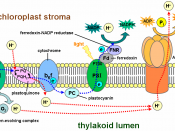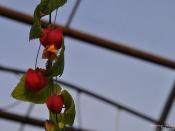Introduction:
Photosynthesis is the trapping of carbon dioxide and its subsequent reduction to carbohydrate, using hydrogen from water. Hexose sugars and starch are commonly formed so the following equation is often used:
light energy
6CO2 + 6H2O C6H12O6 + 6O2
carbon dioxide water chlorophyll carbohydrate oxygen
Photosynthesis consists of two stages: These are the light-dependent reactions, for which light energy is necessary, and the light independent reactions
series of light-dependent reactions that are temperature-independent and a series of temperature-dependent reactions that are light-independent. The rate of the first series, called the light reaction, can be increased by increasing light intensity (within certain limits) but not by increasing temperature. In the second series, called the dark reaction, the rate can be increased by increasing temperature (within certain limits) but not by increasing light intensity
Photosynthesis involves the production of oxygen, and the uptake of carbon dioxide. These can be used as a measure of the rate of photosynthesis.
This experiment will be an investigation into the photosynthetic rate, the rate at which plants produce all their own organic substances (food) using only light energy and simple inorganic substances. The rate of photosynthesis is dependent on environmental factors, particularly the amount of light available, the level of carbon dioxide and the temperature. The effect of these factors can be tested experimentally by altering one of these factors while holding others constant.
We know that light intensity, carbon dioxide concentration and temperature are three factors that can determine the rate of photosynthesis. If the level of one of these factors is changed, rate of photosynthesis changes. Normally, only changes to one of the factors will affect the rate of photosynthesis in a plant at a time. This is the factor that is nearest to its minimum, the limiting factor. Changing the limiting factor...

![Global Photosynthesis Visualized [video]](https://s.writework.com/uploads/5/59070/global-photosynthesis-visualized-video-thumb.jpg)
